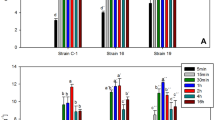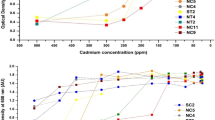Abstract
Cr(VI) is a ubiquitous pollutant that poses a serious threat to human health. Recently, the use of microorganisms to adsorb heavy metals has attracted research attention. However, there are few studies on the biosorption of Cr(VI) by Shewanella putrefaciens, which is a metal-reducing bacterium. In this paper, single-factor experiments were designed to investigate the effect of hexavalent chromium by Shewanella putrefaciens, and response surface methodology (RSM) based on the Box-Behnken design (BBD) was performed to study the Cr(VI) biosorption behavior of Shewanella putrefaciens. The coefficient of determination (R2 = 0.811 for Cr(VI)) and probability value (P < 0.05) demonstrated significance for the obtained regression model. The results showed that the model was suitable for experimental data, and the maximum Cr(VI) removal efficiency by Shewanella putrefaciens was 85.68% under the optimum conditions of a contact time of 16.57 h, pH value of 8, and biomass dosage of 0.42 g/L, which were verified by additional experiments. ANOVA and 3D response graph analysis showed that the variables with significant influences were pH and temperature. In addition, scanning electron microscopy (SEM) results demonstrated that after biosorption of Cr(VI) by Shewanella putrefaciens, granular complexes attached to rough cell surfaces were observed. Furthermore, Fourier transform infrared spectroscopy (FT-IR) analysis showed that the distribution of Cr(VI) on the cell surface was related to the carboxyl, ether, amide, hydroxyl, and phosphoric acid groups of Shewanella putrefaciens. This study is useful to explore the process and mechanism of heavy metal adsorption by Shewanella putrefaciens and provide new ideas for the microbial remediation of metal pollution in water.





Similar content being viewed by others
References
Ahmady-Asbchin, S., Safari, M., & Varposhti, M. (2015). Biosorption optimization of Cr(VI) using response surface methodology and thermodynamics modeling onto Azolla filiculoides. Separation Science, 50(4), 10.
Arivalagan, P., Singaraj, D., Haridass, V., & Kaliannan, T. J. E. E. (2014). Removal of cadmium from aqueous solution by batch studies using Bacillus cereus. Ecological Engineering, 71, 728–735.
Bitton, G., & Freihofer, V. (1977). Influence of extracellular polysaccharides on the toxicity of copper and cadmium toward Klebsiella aerogenes. Microbial Ecology, 4(2), 119–125.
Bucher, J. R. (2007). NTP toxicity studies of sodium dichromate dihydrate (CAS No. 7789-12-0) administered in drinking water to male and female F344/N rats and B6C3F1 mice and male BALB/c and am3-C57BL/6 mice. Toxic Rep Ser, Jan, 72, 1.
Bueno, B. Y. M., Torem, M. L., Molina, F., & Mesquita, L. M. S. D. (2008). Biosorption of lead(II), chromium(III) and copper(II) by R. opacus: equilibrium and kinetic studies. Minerals Engineering, 21(1), 65–75.
Calvo, C., Manzanera, M., Silva-Castro, G. A., Uad, I., & González-López, J. (2009). Application of bioemulsifiers in soil oil bioremediation processes. Future prospects. Science of the Total Environment, 407(12), 3634–3640.
Cervantes, C., Camposgarcía, J., Devars, S., Gutiérrezcorona, F., Lozatavera, H., Torresguzmán, J. C., et al. (2001). Interactions of chromium with microorganisms and plants. FEMS Microbiology Reviews, 25(3), 335–347.
Chakravarty, R., & Banerjee, P. C. (2008). Morphological changes in an acidophilic bacterium induced by heavy metals. Extremophiles Life Under Extreme Conditions, 12(2), 279.
Choińska-Pulit, A., Sobolczyk-Bednarek, J.,& Łaba W. (2018). Optimization of copper, lead and cadmium biosorption onto newly isolated bacterium using a Box-Behnken design. Ecotoxicology and Environmental Safety, 149, 275–283.
Comte, S., Guibaud, G., & Baudu, M. (2008). Biosorption properties of extracellular polymeric substances (EPS) towards Cd, Cu and Pb for different pH values. Journal of Hazardous Materials, 151(1), 185–193.
Deng, L., Yang, Z., Jie, Q., Wang, X., & Zhu, X. (2009). Biosorption of Cr(VI) from aqueous solutions by nonliving green algae Cladophora albida. Minerals Engineering, 22(4), 372–377.
Elshazly, M. O., Morgan, A. M., Ali, M. E., Abdel-Mawla, E., & El-Rahman, S. S. A. (2016). The mitigative effect of Raphanus sativus oil on chromium-induced geno- and hepatotoxicity in male rats. Journal of Advanced Research, 7(3), 413–421.
Erkaya, I. A., Arica, M. Y., Akbulut, A., & Bayramoglu, G. (2014). Biosorption of uranium(VI) by free and entrapped Chlamydomonas reinhardtii: kinetic, equilibrium and thermodynamic studies. Journal of Radioanalytical and Nuclear Chemistry, 299(3), 1993–2003.
Farhan, S. N., & Khadom, A. A. (2015). Biosorption of heavy metals from aqueous solutions by Saccharomyces Cerevisiae. International Journal of Industrial Chemistry, 6(2), 119–130.
Fein, J. B., Fowle, D. A., Cahill, J., Kemner, K., Boyanov, M., & Bunker, B. (2002). Nonmetabolic reduction of Cr(VI) by bacterial surfaces under nutrient-absent conditions. Geomicrobiology Journal, 19(3), 369–382.
Ferreira, S. L. C., Bruns, R. E., Ferreira, H. S., Matos, G. D., David, J. M., Brandāo, G. C., et al. (2007). Box-Behnken design: An alternative for the optimization of analytical methods. Analytica Chimica Acta, 597(2), 179–186.
Gabr, R. M., Hassan, S. H. A., & Shoreit, A. A. M. (2008). Biosorption of lead and nickel by living and non-living cells of Pseudomonas aeruginosa ASU 6a. International Biodeterioration & Biodegradation, 62(2), 195–203.
Gholap, S. G., & Badiger, M. V. (2010). Synthesis and characterization of polyamphoteric hydrogel membrane based on chitosan. Journal of Applied Polymer Science, 93(3), 1454–1461.
Hawley, E. L., Deeb, R. A., Kavanaugh, M. C., & Jacobs, J. A. (2010). Treatment Technologies for Chromium(VI). Cheminform, 37(14), no-no.
Kazy, S. K., D’Souza, S. F., & Pinaki, S. (2009). Uranium and thorium sequestration by a Pseudomonas sp.: mechanism and chemical characterization. Journal of Hazardous Materials, 163(1), 65–72.
Khakpour, H., Younesi, H., & Mohammadhosseini, M. (2014). Two-stage biosorption of selenium from aqueous solution using dried biomass of the baker’s yeast Saccharomyces cerevisiae. Journal of Environmental Chemical Engineering, 2(1), 532–542.
Kim, H. J., Park, H. S., Hyun, M. S., Chang, I. S., Kim, M., & Kim, B. H. (2002). A mediator-less microbial fuel cell using a metal reducing bacterium, Shewanella putrefaciens. Enzyme and Microbial Technology, 30(2), 145–152.
Kotaś, J., & Stasicka, Z. (2000). Chromium occurrence in the environment and methods of its speciation. Environmental Pollution, 107(3), 263–283.
Margesin, R., Zimmerbauer, A., & Schinner, F. (2000). Monitoring of bioremediation by soil biological activities. Chemosphere, 40(4), 339–346.
Maxwell, C. R. (1997). Investigation and remediation of chromium and nitrate groundwater contamination: case study for an industrial facility. Journal of Soil Contamination, 6(6), 733–749.
Mishra, S., & Maiti, A. (2019a). Process optimization for effective bio-decolourization of reactive orange 16 using chemometric methods. Journal of Environmental Science and Health. Part A, Toxic/Hazardous Substances & Environmental Engineering, 54(3), 179–192. https://doi.org/10.1080/10934529.2018.1541383.
Mishra, S., & Maiti, A. (2019b). Study of simultaneous bioremediation of mixed reactive dyes and Cr(VI) containing wastewater through designed experiments. Environmental Monitoring and Assessment, 191(12), 766. https://doi.org/10.1007/s10661-019-7976-0.
Mishra, S., Jyot, J., Kuhad, R. C., & Lal, B. (2001). Evaluation of inoculum addition to stimulate in situ bioremediation of oily-sludge-contaminated soil. Applied and Environmental Microbiology, 67(4), 1675–1681.
Mishra, S., Nayak, J. K., & Maiti, A. (2020). Bacteria-mediated bio-degradation of reactive azo dyes coupled with bio-energy generation from model wastewater. Clean Technologies and Environmental Policy, 22(3), 651–667. https://doi.org/10.1007/s10098-020-01809-y.
Mona, S., Kaushik, A., & Kaushik, C. P. (2011). Biosorption of chromium(VI) by spent cyanobacterial biomass from a hydrogen fermentor using Box-Behnken model. International Biodeterioration & Biodegradation, 65(4), 656–663.
Mondal, A., Appadurai, D. A., Akoum, N. W., Sachse, F. B., & Moreno, A. P. (2017a). Computational simulations of asymmetric fluxes of large molecules through gap junction channel pores. Journal of Theoretical Biology, 412, 61–73.
Mondal, N. K., Samanta, A., Dutta, S., & Chattoraj, S. J. J. (2017b). Optimization of Cr(VI) biosorption onto Aspergillus niger using 3-level Box-Behnken design: equilibrium, kinetic, thermodynamic and regeneration studies. Journal, Genetic Engineering & Biotechnology, 15(1), 151–160.
Namasivayam, C., Prabha, D., & Kumutha, M. (1998). Removal of direct red and acid brilliant blue by adsorption on to banana pith. Bioresource Technology, 64(1), 77–79.
Nourbakhsh, M., Sağ, Y., Özer, D., Aksu, Z., Kutsal, T., & ÇağLar, A. (1994). A comparative study of various biosorbents for removal of chromium(VI) ions from industrial waste waters. Process Biochemistry, 29(1), 1–5.
Palmer, C. D., & Wittbrodt, P. R. (1991). Processes affecting the remediation of chromium-contaminated sites. Environmental Health Perspectives, 92(92), 25–40.
Pons, M. P., & Fusté, M. C. (1993). Uranium uptake by immobilized cells of Pseudomonas strain EPS 5028. Applied Microbiology and Biotechnology, 39(4–5), 661–665.
Poornima, K., Karthik, L., Swadhini, S. P., Mythili, S., & Sathiavelu, A. (2010). Degradation of chromium by using a novel strains of Pseudomonas species. Journal of Microbial & Biochemical Technology, 4, 95–99.
Propst, T. L., Lochmiller, R. L., Qualls, C. W., & Mcbee, K. (1999). In situ (mesocosm) assessment of immunotoxicity risks to small mammals inhabiting petrochemical waste sites. Chemosphere, 38(5), 1049–1067.
Richard, F. C., & Bourg, A. C. M. (1991). Aqueous geochemistry of chromium: a review. Water Research, 25(7), 807–816.
Ririhena, S. A. J., Astuti, A. D., Fachrul, M. F., Silalahi, M. D. S., Hadisoebroto, R., & Rinanti, A. (2018). Biosorption of heavy metal copper (Cu2+) by Saccharomyces cerevisiae. IOP Conference Series Earth and Environmental Science,106(1), 012090.
Scott, J. A., & Palmer, S. J. (1990). Sites of cadmiun uptake in bacteria used for biosorption. Applied Microbiology and Biotechnology, 33(2), 221–225.
Semple, K. T., Dew, N. M., Doick, K. J., & Rhodes, A. H. (2006). Can microbial mineralization be used to estimate microbial availability of organic contaminants in soil? Environmental Pollution, 140(1), 164–172.
Sukumar, C., Janaki, V., Kamala-Kannan, S., & Shanthi, K. (2014). Biosorption of chromium(VI) using Bacillus subtilis SS-1 isolated from soil samples of electroplating industry. Clean Technologies and Environmental Policy, 16(2), 405–413.
Swift, D. T., & Forciniti, D. (2015). Accumulation of lead by Anabaena cylindrica : mathematical modeling and an energy dispersive X-ray study. Biotechnology and Bioengineering, 55(2), 408–418.
Tsai, T. T., Kao, C. M., Surampalli, R. Y., & Chien, H. Y. (2009). Enhanced bioremediation of fuel-oil contaminated soils: laboratory feasibility study. Journal of Environmental Engineering, 135(9), 845–853.
Walworth, J., Pond, A., Snape, I., Rayner, J., Ferguson, S., & Harvey, P. (2007). Nitrogen requirements for maximizing petroleum bioremediation in a sub-Antarctic soil. Cold Regions Science and Technology, 48(2), 84–91.
Wang, S., & Mulligan, C. N. (2004). An evaluation of surfactant foam technology in remediation of contaminated soil. Chemosphere, 57(9), 1079–1089.
Wang, T., & Sun, H. (2013). Biosorption of heavy metals from aqueous solution by UV-mutant Bacillus subtilis. Environmental Science and Pollution Research, 20(10), 7450–7463.
Wang, X., Chen, M., Xiao, J., Hao, L., Crowley, D. E., Zhang, Z., et al. (2015). Genome sequence analysis of the naphthenic acid degrading and metal resistant bacterium Cupriavidus gilardii CR3. PLoS One, 10(8), e0132881.
Xu, C., Wang, J., Yang, T., Chen, X., Liu, X., & Ding, X. (2015). Adsorption of uranium by amidoximated chitosan-grafted polyacrylonitrile, using response surface methodology. Carbohydrate Polymers, 121, 79–85.
Yang, X. Y., Zhang, J. P., Lin, G., He, Z., & Yang, Z. (2012). Solvent impregnated resin prepared using ionic liquid Cyphos IL 104 for Cr(VI) removal. Transactions of Nonferrous Metals Society of China, 22(12), 3126–3130.
Yin, H., He, B., Peng, H., Ye, J., Yang, F., & Zhang, N. (2008). Removal of Cr(VI) and Ni(II) from aqueous solution by fused yeast: study of cations release and biosorption mechanism. Journal of Hazardous Materials, 158(2), 568–576.
Acknowledgments
We would like to thank the Analytical and Testing Center of Sichuan University for the FTIR and SEM imaging.
Funding
This work was financially supported by the National Natural Science Foundation of China (Grant No. 21571163).
Author information
Authors and Affiliations
Corresponding author
Ethics declarations
Conflict of Interest
The authors declare that they have no conflict of interest.
Additional information
Publisher’s Note
Springer Nature remains neutral with regard to jurisdictional claims in published maps and institutional affiliations.
Article Impact Statement: This article is helpful to investigate the biosorption process and mechanism of heavy metals by Shewanella putrefaciens more quickly and accurately.
Rights and permissions
About this article
Cite this article
Cheng, J., Gao, J., Zhang, J. et al. Optimization of Hexavalent Chromium Biosorption by Shewanella putrefaciens Using the Box-Behnken Design. Water Air Soil Pollut 232, 92 (2021). https://doi.org/10.1007/s11270-020-04947-7
Received:
Accepted:
Published:
DOI: https://doi.org/10.1007/s11270-020-04947-7




